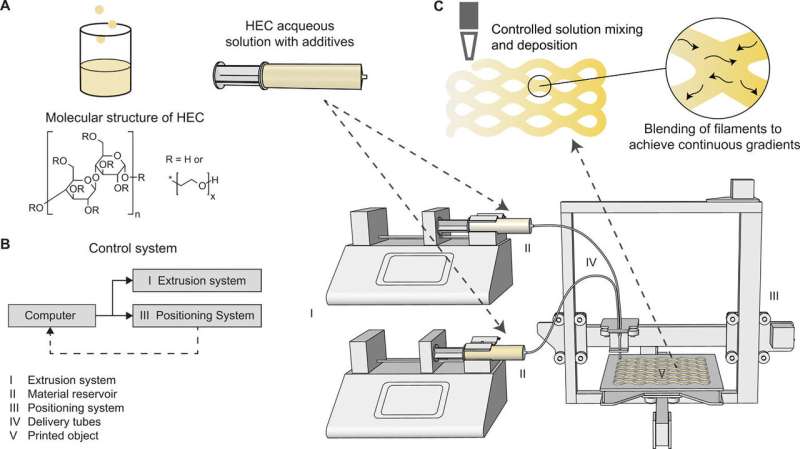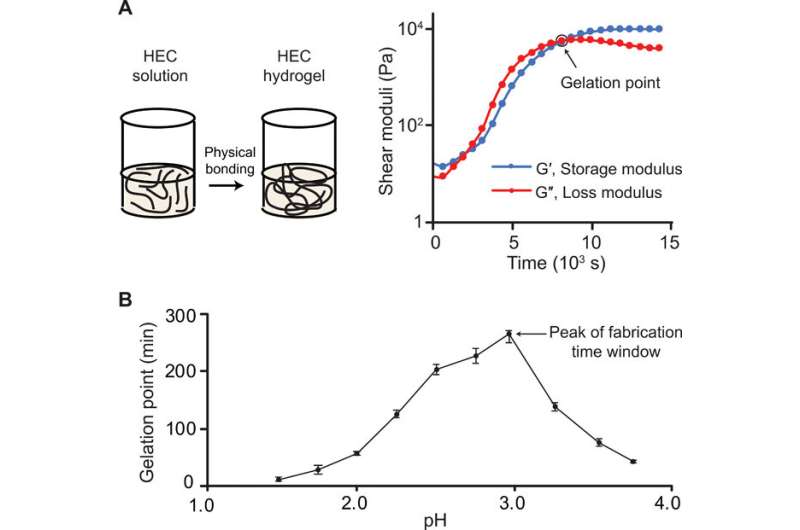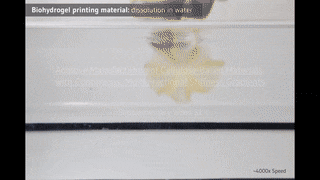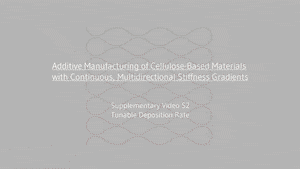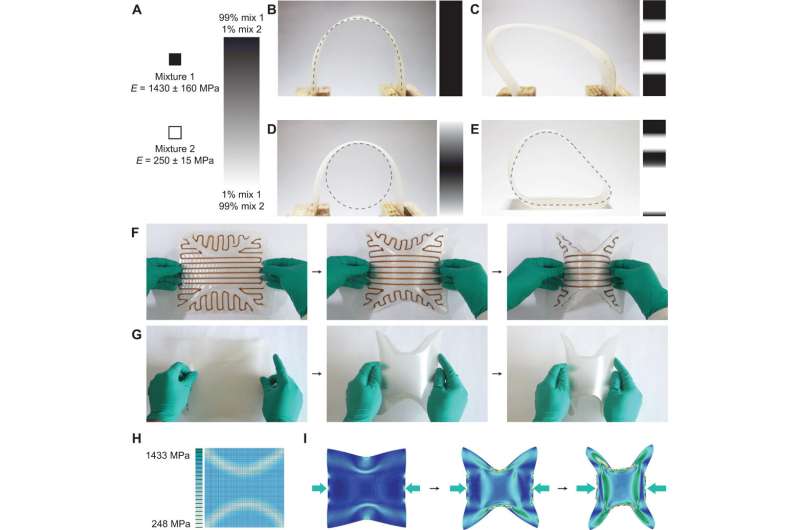Schematics of the fabrication process for printing continuous gradients. (A) Schematic of the preparation of printing solutions. Hydroxyethyl cellulose (HEC) in powder form is dissolved in water and mixed with additives in a beaker before being transferred into a syringe. (B) Diagram of the control system and schematics of the 3D printing system. The diagram (left) shows the communication workflow that synchronizes the (I) extrusion system and (III) positioning system through a feedback loop. The 3D printing system (right) consists of (I) an extrusion system (one or two syringe pumps), (II) the reservoirs (syringes), and (III) a positioning system (customized low-cost 3D printer TEVO Tarantula i3). Delivery tubes (IV) are equipped with extruding tips and transport the printing solutions and deposit filaments of the solutions on the printing platform (V). (C) Illustration showing the blending of filaments after deposition. Neighboring filaments blend into each other through the diffusion at the molecular scale, thus creating seamless objects and continuous gradients. Credit: Science Advances, doi: 10.1126/sciadv.aay0929
Functionally graded materials (FGM) allow diverse applications in multidisciplinary fields from biomedicine to architecture. However, their fabrication can be tedious relative to gradient continuity, interfacial bending and directional freedom. Most commercial design software does not include property gradient data—hindering the exploration of design space suited for FGMs. In a new report on Science Advances, Pedro A.G.S. Giachini and a research team in architecture and urban planning, physical intelligence and medicine, in the U.S., Germany and Turkey designed a combined approach of materials engineering and digital processing. The method facilitated extrusion-based multimaterial, additive manufacturing of cellulose-based, tunable viscoelastic materials.
The constructs maintained continuous, high-contrast and multidimensional stiffness gradients. Giachini et al. established a method to engineer sets of cellulose-based materials with similar compositions, yet with distinct mechanical and rheological properties. The team also parallelly developed a digital workflow to embed gradient information into design models with integrated fabrication path planning. The team combined the physical and digital tools to achieve similar stiffness gradients through multiple pathways to achieve open design possibilities that were previously limited to rigid coupling of material and geometry.
Functionally graded materials (FGMs) can gradually change composition or structure in a continuous, stepwise manner to give rise to changing properties of a composite. Principles of material design are similar to many naturally occurring substrates, built to fulfil multiple, at times conflicting design requirements in diverse fields including thin film coatings, biomedical engineering and architecture. The FGMs can better distribute stress at interfaces, program deformation of soft actuators and influence the speed of cell migration.
Rheological properties of the printing solution. (A) A schematic on the left shows the gelation of the printing solution as a result of physical bonding. The plot of shear moduli versus time on the right shows the gelation point occurring at ~5800 s. By convention, the gelation point is defined as the point in time at which the storage modulus G′ becomes greater than loss modulus G″ after the initial dissolution of HEC species. (B) A plot showing the dependence of gelation time as a function of the pH of the printing solutions. The pH was adjusted by the addition of varying amounts of CA. Error bars denote the SD of three trials. The plot reveals that the highest gelation point, and therefore the longest printing time window, occurs at a pH of ~3.0. Credit: Science Advances, doi: 10.1126/sciadv.aay0929
Giachini et al. combined materials engineering and digital processing as an FGM manufacturing method for constructive and mass transport processes to create continuous gradients. They accomplished this by engineering solutions of a cellulose derivative to provide tunable viscoelastic properties with controlled extrusion, while using the digital workflow to embed gradient information into the designs and generate a custom G-code to control the operational system [three-dimensional (3-D) printer and syringe pumps]. The team used filaments of varying compositions and cross-sections to facilitate molecular diffusions across filament boundaries and create continuous gradients. They highlighted the relevance of combining materials engineering with custom manufacturing technologies and an environmentally friendly and abundant biopolymer-based fabrication material. By designing such physical and digital tools, the team will be able to create multidimensional and continuous stiffness gradients via a variety of methods to expand design possibilities for FGMs.
Giachini et al. selected hydroxethyl cellulose (HEC); a thickening and gelling derivative of cellulose as the base material, due to its non-toxic, biodegradable and environmentally friendly constitution. The gelation point of HEC occurred at 96 minutes, transitioning from an aqueous solution to a solid hydrogel. The scientists optimized the solution parameters to minimize the rate of solution viscosity. When they added citric acid (CA) to the solution, the gelation rate slowed down the most for satisfactory extrusion consistency. The team then characterized the printed material to understand the effect of additives, where the addition of lignin significantly increased the stiffness and tensile strength, while the inclusion of CA decreased these mechanical properties. The combined lignin- and CA-differentiated solutions provided a variety of mechanical properties to print objects with property gradients. The team then noted a decrease in stiffness and increase in size and weight of printed samples with increasing relative humidity, which they explored for applications involving shape-changing structures.
Biocompatibility of the material and its dissolution in water. Credit: Science Advances, doi: 10.1126/sciadv.aay0929
During the design-to-fabrication workflow, the team combined geometric models with gradient data to create FGM data and generate a fabrication code. As a platform for this workflow, they used Grasshopper; a visual programming interface embedded within the 3-D modelling software Rhinoceros 3-D. The team varied the fabrication parameters to create the graded objects of interest by superimposing layers, varying the amount of the material and its composition.
The fluidity of materials with lower viscosity provided object continuity, while more viscous mixtures discretely altered the stiffness. The diffusion between contrasting materials guaranteed interlayer continuity to create continuous and pliable sheets of material with patterned reinforcements. The deposition rate depended on the extrusion rate of the syringe pumps and the speed of the printer's nozzle. Giachini et al. embedded these fabrication parameters in the geometric data and translated the data into fabrication commands to coordinate the distribution of material, explore material flow and allow equal deposition paths to manufacture objects with varied geometric stiffness.
Tunable deposition rate. Credit: Science Advances, doi: 10.1126/sciadv.aay0929
They designed data of mixing ratios, for translation into fabrication codes that modified the extrusion rate of the syringe pumps and developed a computational strategy to optimize the path of deposition to address the challenges of the setup. The sample fabricated using the gradient-optimized path showed higher material contrast immediately after deposition. The team tuned the gradients at the local and global scales using the developed strategies. They tuned the local stiffness according to the material's Young's modulus to control material distribution and influence object deformation. For example, Giachini et al. submitted the materials to external forces to achieve distinct deformation behaviors by distributing stiffness along specific directions or patterns.
The approach of using external force to generate the final shape of an initially flat object will allow designers to leverage simplified 2-D manufacturing strategies and avoid complex 3-D processes. The method will have applications in industrial product designs, architectural design systems that explore elastic bending of planar objects to achieve form and structural integrity and in developing compliant mechanisms and soft robotics. The team validated their experimental observations using a simulation, which mirrored the physical prototype, providing feedback on the distribution of stresses in the deformed sample.
Samples showing programmable deformation due to patterned stiffness variation. (A) A schematic showing stiffness gradients represented by a grayscale image. Mixture 1 has 10 wt % base mixture, and mixture 2 has 10 wt % base mixture and 4 wt % CA. (B to E) Thin cellulose strips of identical size were printed with various stiffness gradient profiles along their length and exhibit different curvature profiles when subjected to the same external displacement. (B) Photograph showing that homogenous stiffness (no gradient) resulted in a symmetric curvature profile. (C) Photograph showing that discrete regions of the weaker mixture resulted in hinge-like behavior that distorted this strip’s curvature profile from the nongraded symmetric curve. (D) Photograph showing a gradual sinusoidal gradient resulted in a curvature profile approximating a circle. (E) Photograph showing that the desired closed end form of this strip was achieved through the printed stiffness gradient, where the weaker regions bent more readily than the stiffer regions. (F and G) Series of photographs of flexible graded sheets that transferred load in the transversal direction to large body deformation in the longitudinal direction for a programmed folding effect. These identical programmed behaviors were achieved by different methods as described in the “Stiffness gradient patterning and applications” section. (F) Sample exhibiting geometric stiffness differentiation through directional placement of reinforcing ribs of higher cross section. (G) Sample exhibiting E modulus differentiation achieved by using a mixture of higher CA content in the regions that were meant to fold. (H) A digital mesh model of the sheet featured in part (G). A fine gradation of E modulus values was applied to approximate the sheet’s continuous gradient. (I) Series of snapshots of the FEM simulation that was developed to predict the programmed folding behavior under a pair of applied forces, represented by the blue block arrows (photo credit: Sachin S. Gupta, University of Stuttgart). Credit: Science Advances, doi: 10.1126/sciadv.aay0929
In this way, Pedro A.G.S. Giachini and colleagues combined materials engineering and digital processing to control material mixing and deposition to extrude tunable, viscoelastic materials with continuous, high-contrast and multidirectional stiffness gradients. They established a method to engineer a base solution into a catalog of fluidic cellulose-based materials containing district mechanical and rheological properties to provide a physical foundation for stiffness gradients. The flexibility of the method allowed the team to adapt scalable and adaptable processes that can be applied to a variety of gradient fabrication processes. The developed method will be further optimized to overcome limitations and push the existing potential to print 2-D or 2.5-D objects and create fully-formed 3-D objects with internal functional property gradients.
More information: P. A. G. S. Giachini et al. Additive manufacturing of cellulose-based materials with continuous, multidirectional stiffness gradients, Science Advances (2020). DOI: 10.1126/sciadv.aay0929
Daniela Rus et al. Design, fabrication and control of soft robots, Nature (2015). DOI: 10.1038/nature14543
Falguni Pati et al. Biomimetic 3-D tissue printing for soft tissue regeneration, Biomaterials (2015). DOI: 10.1016/j.biomaterials.2015.05.043
Journal information: Science Advances , Nature , Biomaterials
© 2020 Science X Network
